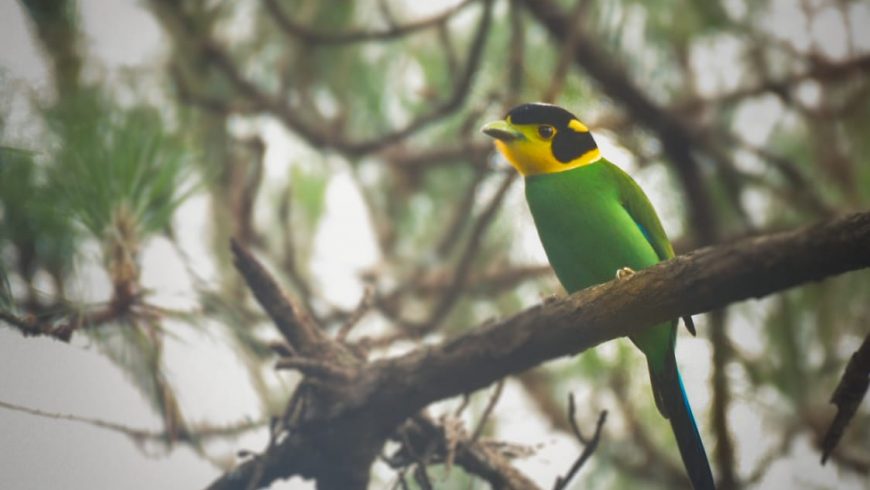Leons Mathew Abraham¹, Taniya Talwar²
¹Captive Breeding Manager
Pygmy Hog Research and Breeding Centre, Bashistha
Basistha, Guwahati, Assam 781029
leonsreptar@gmail.com
²Ecologist, 7weaves Research Foundation
Bye lane 4, Bhetapara Beltola Road, Beltola, Guwahati, Assam 781007
taniya@7weaves.com
Asian Broadbills are brightly coloured birds found only in the woods of South and Southeast Asia. The family Eurylaimidae (Asian and Grauer’s broadbill) contains eight species. Two species of Asian Broadbill call the Indian subcontinent home, both of which can be found in the Himalayas and the Northeast India. They are a sui generis, as their striking plumage, which is highlighted by brilliant contrasting colours, as well as their throaty calls, are unlike that of any bird. Another distinctive feature of the birds in this genus is their broad heads, bills and stocky necks.
Eurylamidae birds are suboscines and not oscines. Oscines are passerine birds. They have a fairly-complicated syrinx (voice box in birds, analogous to the larynx in humans) musculature, whereas suboscines have a primitive syrinx. Suboscines are obliged to live with subpar melodies, which are considerably less intricate than those of oscines. They also have a decurved beak with a hook that is used to hunt arthropods, mainly orthopterans. Though it belongs to the aerial insectivore guild and spends most of its time in the mid-layer of the forest profile, it also consumes fruits and crustaceans occasionally.
There are two species of Asian Broadbills found in the Indian Subcontinent and they are as follows:
Long-tailed Broadbill
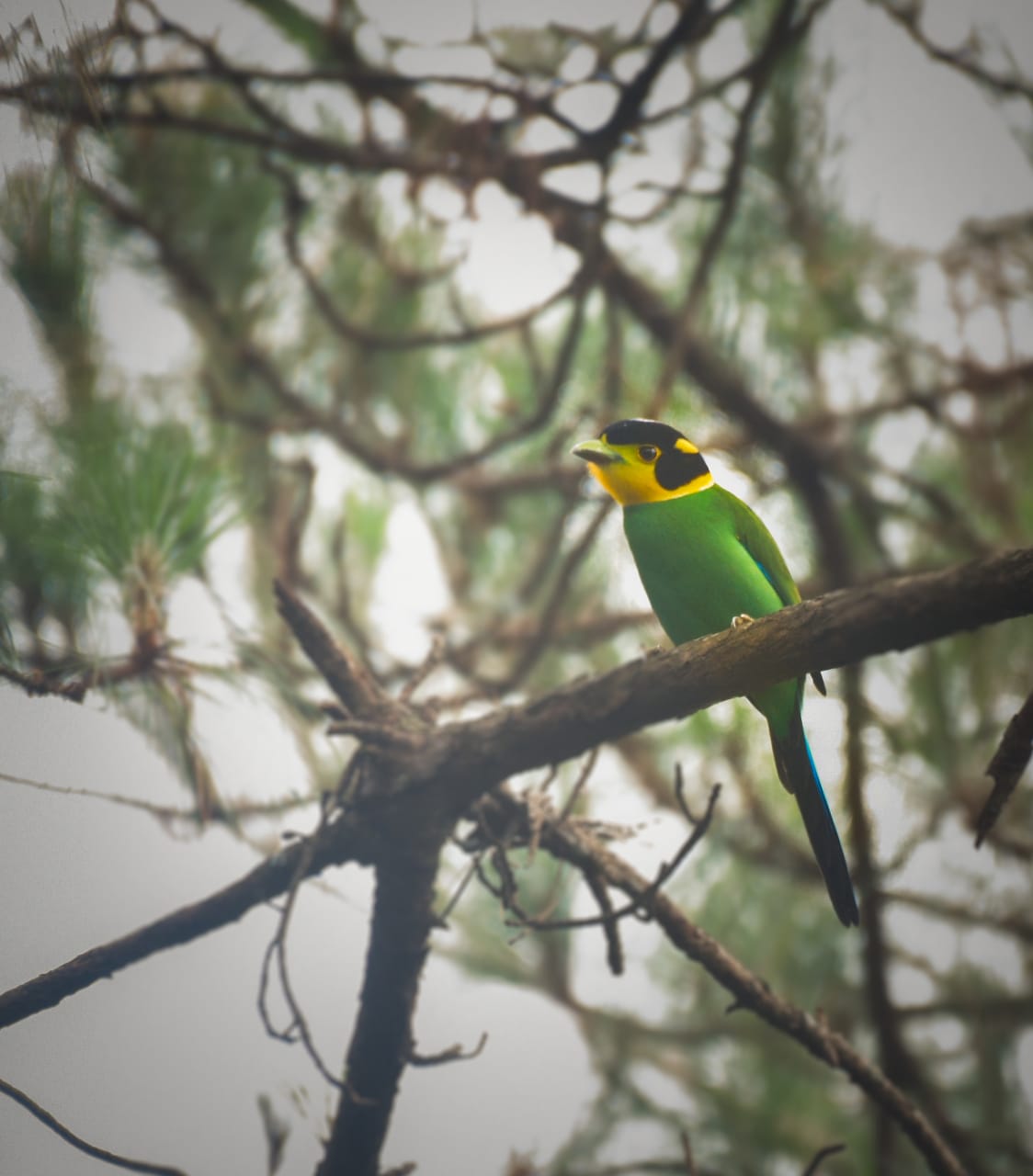
A Long-tailed Broadbill on a Khasi Pine tree. Shillong, Meghalaya. ©Leons Mathew Abraham
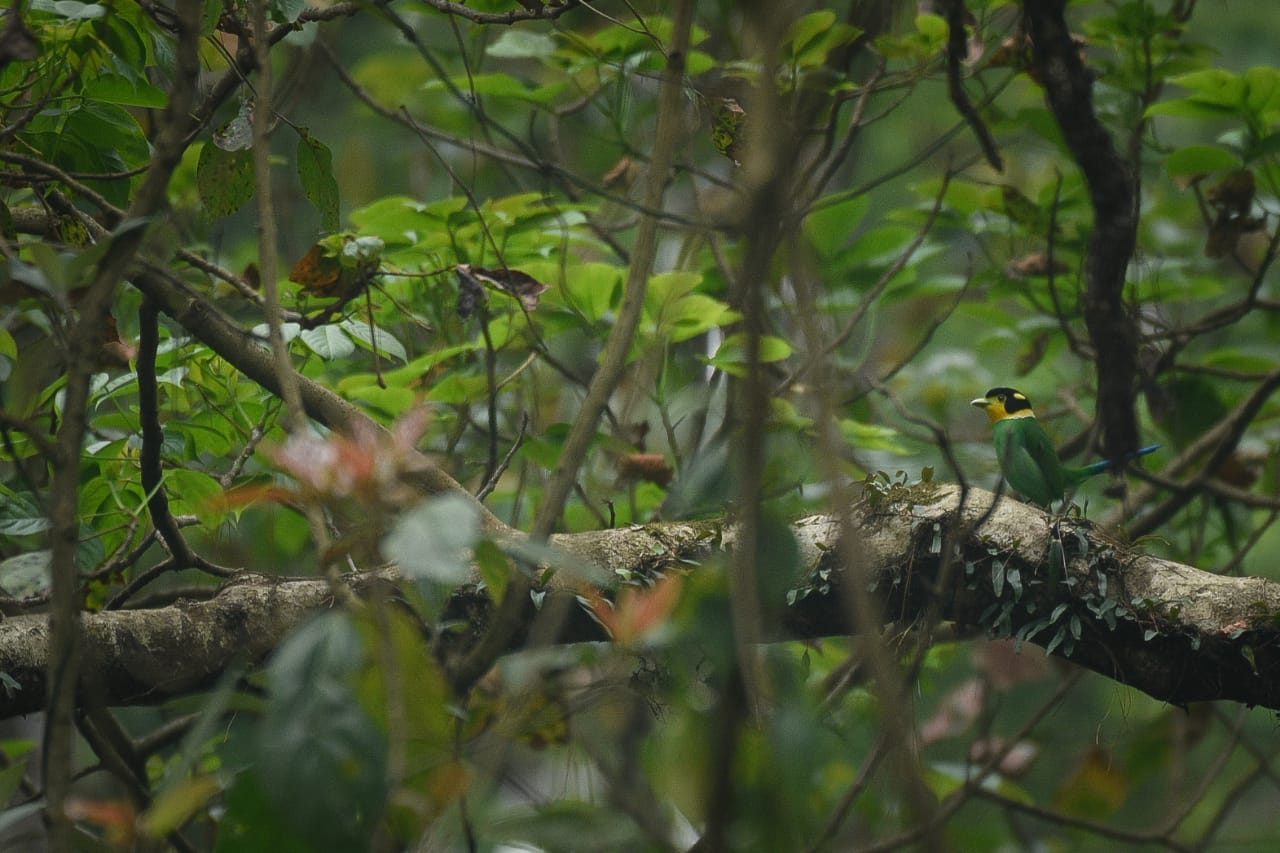
A Long-tailed Boradbill hopping on wood in search of insects. ©Leons Mathew Abraham
Long-tailed Broadbills belong to the genus Psarisomus. A monotypic species with a distinct look. The plumage on the head is very peculiar. On either side of the black head are two yellow spots. A vivid golden colour covers the face and bottom half of the head. The body is greenish blue with a jet blue tail. The males of this species have a large blue crown patch, whereas the females have a considerably smaller one. Juveniles also have lighter plumage than adults.
They are always found in huge flocks with other species, except during the breeding season. The nests are built haphazardly, and reproduction happens mostly during the monsoon season. Nests in the shape of pears are hung from the branches of tall trees.
Silver-breasted Broadbill
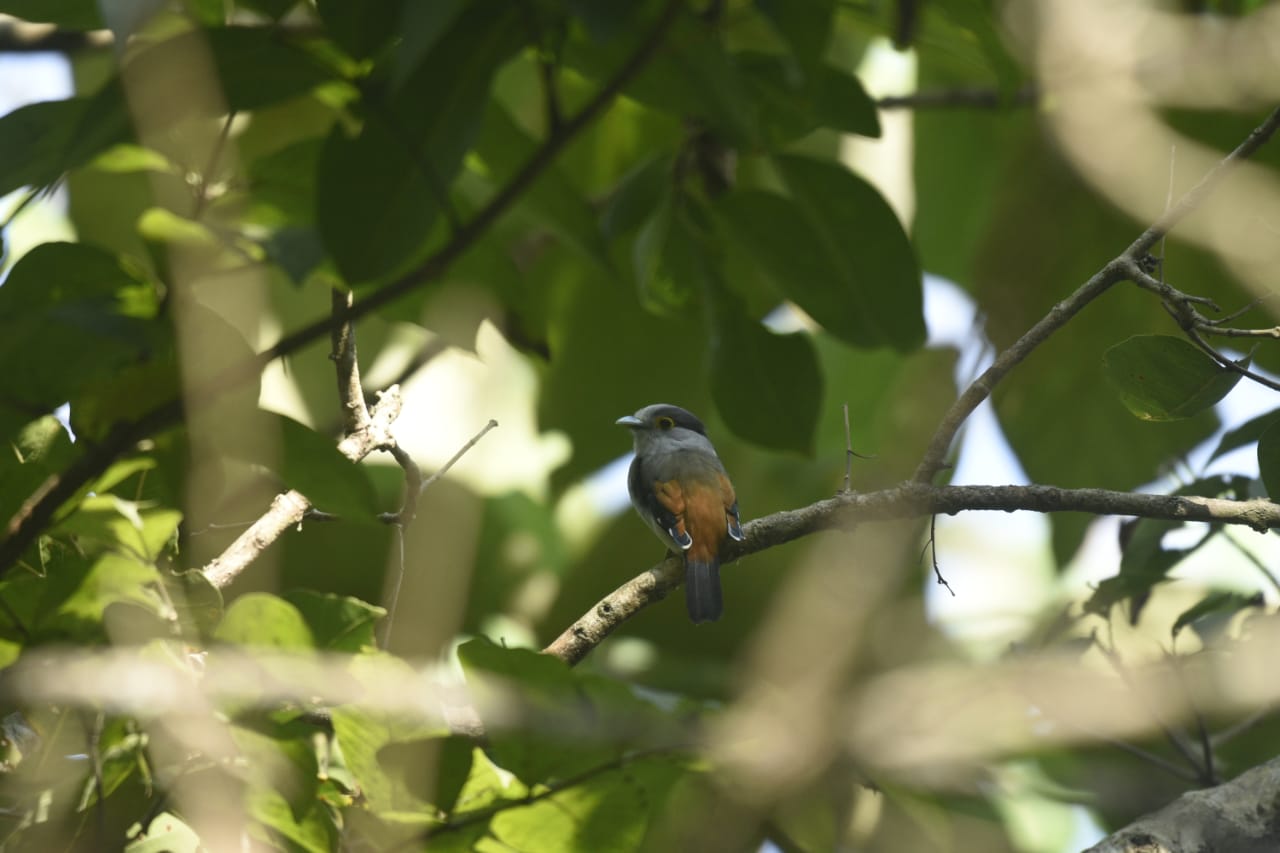
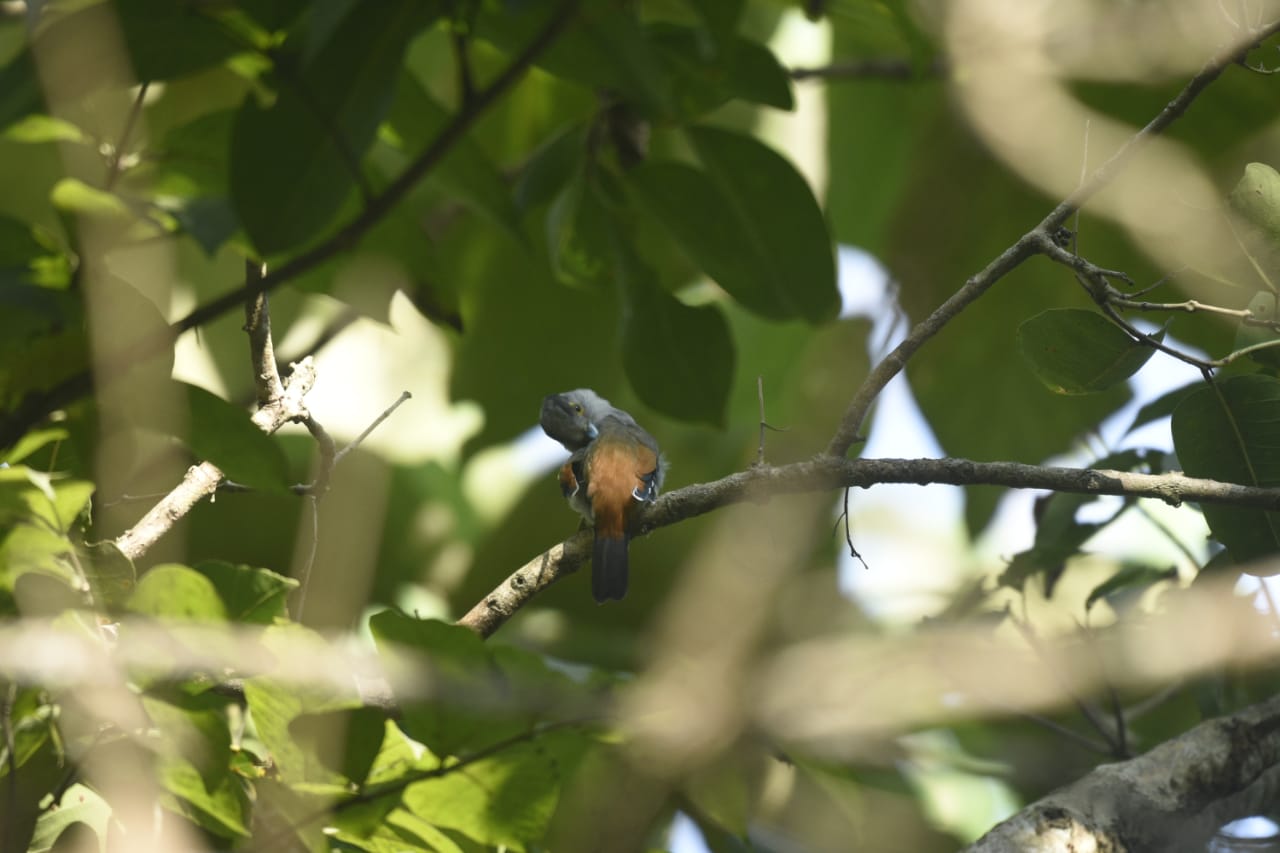
A Silver-breasted Boradbill perched on a teak tree. Garbhanga Wildlife Sanctuary, Guwahati, Assam. ©Leons Mathew Abraham
The Silver-breasted Broadbill is the only species of the genus Serilophus, which means ‘silk’ since the bird feathers appear to be smooth. It has a large, ponderous head with a black supercilium, a short flat crest that extends over the nape, and a yellow eye-ring. The blue and black patterns on the bird’s wings are intricate. The underbelly is whitish-grey, the rump is light chestnut, and the tail is black towards the tip. The only difference between the sexes is that the female has a silver ring on the breast.
The birds are crepuscular and arboreal in nature. They are generally observed in the lower branches of tall trees and move in tight packs in wooded areas. Birds from higher elevations may migrate to lower elevations and plains in the winter. Their breeding season runs from late spring through the middle of summer. The nest, which is a massive, cluttered ball lined with bamboo or grass leaves and hangs from the branch’s end, is built by both sexes.
The majority of Eurylaimid Broadbill species have experienced significant population decreases in recent years. Long-tailed Broadbills are common in many locations, yet their populations have declined significantly in the northern half of their range. Meanwhile, the population of Silver-breasted Broadbills has plummeted over much of its territory, becoming extinct in some countries such as Nepal. Both species have become extinct in Singapore. Beautiful and distinctive forest birds like this are threatened by a myriad of threats.
Habitat Fragmentation

Habitat fragmentation due to road construction in Thain Mawdem forest, Ri-Bhoi, Meghalaya ©Taniya Talwar
Habitat fragmentation brings long-term modifications to structure and functionality of an area into smaller, isolated sections. The primary causes are slower geological processes that alter the physical environment and web of human-modified land. Large-scale and ongoing studies on fragmentation provide conclusive evidence that ecosystems are suffering from negative effects on biodiversity and ecological processes. These effects include decreased fragment area (patch-size effect, which results in a smaller landscape and more barriers), increased habitat isolation (isolation effect, which can result in inbreeding and genetic abnormalities), and increased edge effects (edge effect, which can result in great change in biotic and abiotic predation of native species)
Illegal logging

Degraded woodland illegally logged. Thain Mawdem forest, Ri-Bhoi district, Meghalaya. © Taniya Talwar
Illegal logging frequently targets valuable species and leads to the selective eradication of some species. Frequently, these are tall, durable and endemic species that are eliminated from forests. Forests become less stable, and productive when specific habitat and structural components are lost. Even though these species might not be sources of fruit or food for the wildlife, they are crucial as nest trees and links throughout the upper canopy.
Encroachment into forest areas
Fragmentation tends to result from encroachment. The habitat eventually collapses when the landscape is too fragmented to support a large-scale ecology, which results in biodiversity loss. Huge numbers of organisms are obliterated in the process of encroaching, including microorganisms, insects and plants. Added to it, the establishment of plant and animal colonies after intrusion are also prevented.
Jhum cultivation
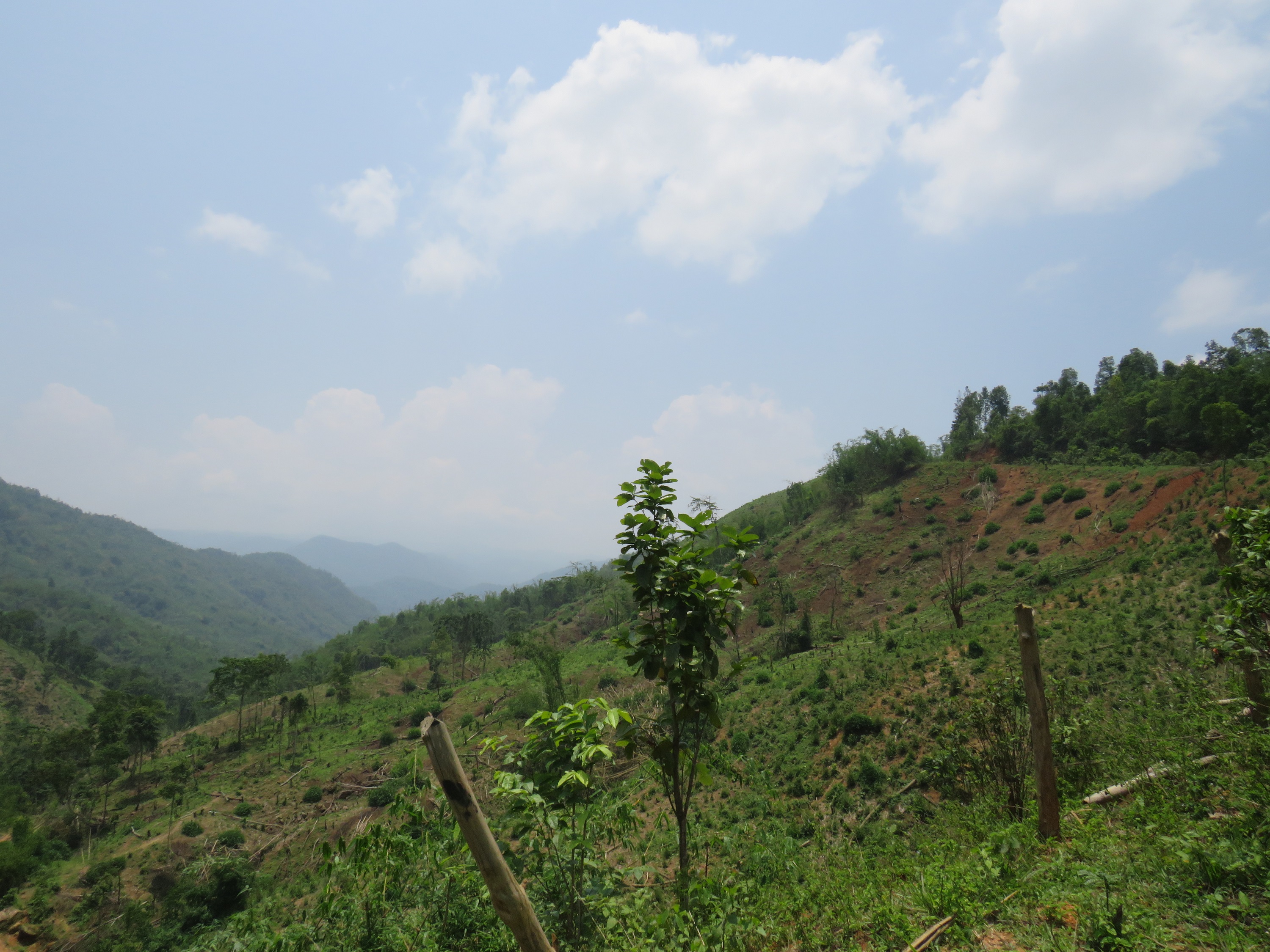
Jhum cultivation in the denuded hill in Thain Mawdem forest, Ri-Bhoi Meghalaya. ©Taniya Talwar
Jhum cultivation not only upsets the ecological balance but also has a variety of negative effects on the soil and climate (soil erosion lowers soil fertility, which leads to low productivity and strain on the land). Anthropogenic activity has altered the ecosystem of the natural forest, resulting in a poorly diversified man-made and natural landscape. Increasing Jhum practises results in reduced rainfall owing to habitat degradation, which in turn, diminishes biological diversity and leads to the extinction of indigenous species that were previously unknown.
References:
- Aggerbeck, M., Fjeldså, J., Christidis, L., Fabre, P.H. and Jønsson, K.A. (2014). Resolving deep lineage divergences in core corvoid passerine birds supports a proto-Papuan island origin. Molecular Phylogenetics and Evolution. 70: 272–285.
- Aidala, Z., Chong, N., Anderson, M.G., Ortiz-Catedral, L., Jamieson, I.G., Briskie, J.V., Cassey, P., Gill, B.J. and Hauber, M.E. (2013). Phylogenetic relationships of the genus Mohoua, endemic hosts of New Zealand’s obligate brood parasitic Long-tailed Cuckoo (Eudynamys taitensis). Journal of Ornithology. 154(4): 1127–1133.
- Bruce, M.D. (2020). Long-tailed Broadbill (Psarisomus dalhousiae), version 1.0. In Birds of the World (J. del Hoyo, A. Elliott, J. Sargatal, D. A. Christie, and E. de Juana, Editors). Cornell Lab of Ornithology, Ithaca, NY, USA. https://doi.org/10.2173/bow.lotbro1.01
- Rasmussen, P. C., and J. C. Anderton (2005). Birds of South Asia. The Ripley Guide. Volumes 1 and 2. Smithsonian Institution, Washington, DC, USA and Lynx Edicions, Barcelona, Spain.
- Haddad N.M.; Brudvig, L. A.; Clobert, J.; Davies, K.F.; Gonzalez, A.; Holt, R.D.; Lovejoy, T.E.; Sexton J.O.; Austin, M.P.; Collins, C.D.; Cook, W.M.; Damschen, E.I.; Ewers, R.M.; Foster B.L.; Jenkins, C.N.; King, A.J.; Laurance, W.F.; Levey, D.J.; Margules, C.R.; Melbourne, B.A.; Nicholls, A.O.; Orrock, J.L.; Song, D.X. and Townshend, J.R. (2015) Habitat fragmentation and its lasting impact on Earth’s ecosystems. Haddadet al. Sci. Adv1, e1500052
- Fatima, K.; Muhammad, B.T.; Asma, J.; Huda, K.; Tahira, A. et al., (2019). Multiple Impacts of Illegal Logging: A key to Deforestation Over the Globe. Biomed. J. Sci. Tech. Res. 20(5)- 2019. BJSTR. MS.ID.003519.
- Zakkak, S.; Kakalis, E.; Radović, A.; Halley, J. and Kati, V. (2013). The impact of forest encroachment after agricultural land abandonment on passerine bird communities: The case of Greece. Journal for Nature Conservation. 22. 10.1016/j.jnc.2013.11.001.
- Sarma, K. (2013). Impact of Slash-And-Burn Agriculture on Forest Ecosystem in Garo Hills Landscape of Meghalaya, North-East India. Journal of Biodiversity Management & Forestry. 01. 10.4172/2327-4417.1000102.
- Shangpliang, L.M. (2019) Agro-forestry: An alternative for Jhum Cultivation in Meghalaya. The NEHU Journal, XVII(1 and 2): 61-70.

